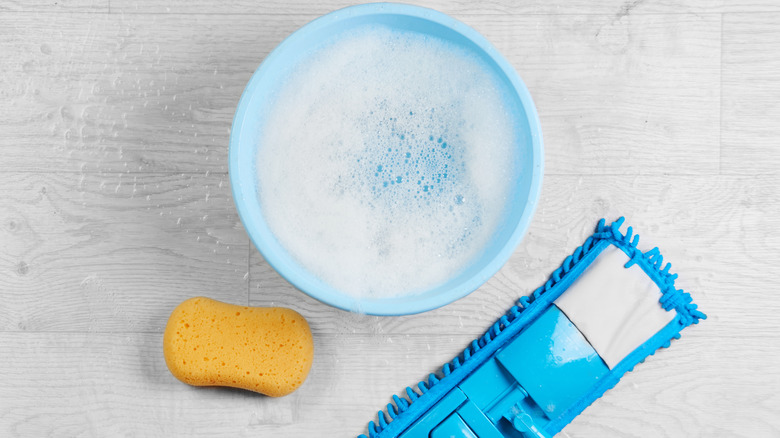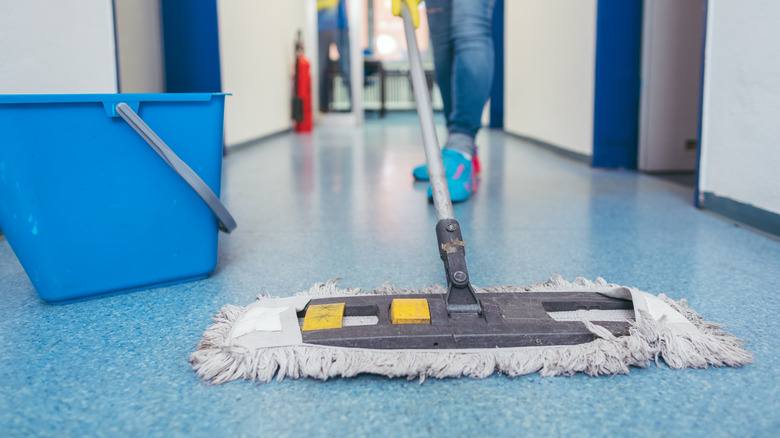The Biggest Mistakes You're Making When Cleaning With Pine-Sol
Since it first came on the market, Pine-Sol has become a practical go-to for deodorizing and disinfecting. Whether you're washing walls, wiping down counters, or mopping, Pine-Sol proves to be a multi-purpose cleaner, as per Simple at Home. You can use it to disinfect surfaces, especially when spraying it onto a tabletop or an appliance. The product eliminates almost 99.9% of germs; plus, it's safe to use on stainless steel. Another idea is to spray Pine-Sol onto carpet or furniture to keep a cat away, though you'll need to test a small area first to make sure it doesn't stain.
However, like with any other cleaner, you might make a mistake when cleaning with Pine-Sol. While you can safely apply it to many types of surfaces, there are a few that you'll need to avoid. Pine-Sol is also unsafe for certain types of flooring since there's a risk of rubbing off the floor's finish. Here's what to avoid when cleaning with Pine-Sol, so you don't make cleaning mistakes that cause more mess than order.
Mixing bleach when cleaning with Pine-Sol
Combining Pine-Sol with bleach puts you in a potentially hazardous situation. According to HomeSteady, this is one chemistry set you don't want to play with. Ethoxylated alcohol counts as one of the components in Pine-Sol, and when it mixes with bleach, it produces chlorine gas. If you're unfortunate enough to get exposed to these fumes, you might suffer from eye issues, namely some unpleasant irritation. Also, you might start vomiting. In addition to these symptoms, your breathing becomes difficult and painful if you're exposed to the gas for a more extended period of time.
Even in a well-ventilated area, this situation can pose a problem, so your safest bet is to avoid mixing these two cleaning agents. Besides, you're not increasing any disinfecting properties, as each type of cleaner works well on its own when it comes to killing germs, nixing mold, and getting rid of mildew.
Mixing other solvents with Pine-Sol
As noted by Prudent Reviews, the manufacturer's recommendations warn consumers not to mix Pine-Sol with any other household cleaners. Not only is it dangerous, but you're not maximizing the germ-killing power of the product by mixing it since it already kills 99.9% of germs. Pine-Sol already consists of two agents, propylene glycol and benzoic acid, that are instrumental in eliminating stains and odors while knocking out bacteria and mold. Therefore, if you're looking to do a deep clean, you can use undiluted Pine-Sol to utilize its full strength. Only do this if the formula doesn't react harshly with what you're planning to clean and if the area where you're working is well ventilated.
With that in mind, also note that these chemicals interact with other solvents like vinegar and ammonia by emitting fumes. This is why the manufacturers recommend against mixing Pine-Sol with other cleaning solutions because these fumes can be dangerous.
Not measuring correctly when cleaning with Pine-Sol
You may have heard the rule that you should add no more than 1 tablespoon of bleach to 1 gallon of water when diluting it for cleaning purposes. Pine-Sol works differently because you would need at least 1/4 of a cup of the solution to 1 gallon of water, as per Pine-Sol. You can then either pour it into a bucket or a spray bottle. Specifically, this measurement pertains to cleaning countertops, stovetops, laminate flooring, wood flooring, and sinks.
The ratio of Pine-Sol to water is important. When we often try to clean up quickly, we can get sloppy and add too much or too little cleaner to the water. This can easily happen if you're pouring Pine-Sol straight from the bottle to the container of water. To avoid that, keep a measuring cup near the bottle that can measure up to 1/4 of the solution to maintain the mixture's potency.
Cleaning the wrong surfaces with Pine-Sol
Another mistake you might make when cleaning with Pine-Sol is using it on the wrong surfaces. According to Pine-Sol, you should refrain from using undiluted Pine-Sol on metal surfaces, such as copper or aluminum. However, it does not harm stainless steel. Instead, you can try using Pine-Sol diluted in water on a small spot that's not visible to test how it reacts with the metal. But your safest option is to use a different cleaner.
Additionally, you should avoid cleaning marble tile or countertops with the solution, as well as surfaces that are covered with acrylic, enamel, or oil paint. They will be stripped of their coating if you wipe them down with Pine-Sol (via Hunker). One other mistake people make when cleaning with Pine-Sol is applying it to cars or dishes. Pine-Sol contains sodium secondary alkyl sulfate, propylene glycol, and benzoic acid, which has a corrosive effect on these materials (via SmartLabel).
Cleaning vinyl or linoleum floors with Pine-Sol
When considering which surfaces to avoid when cleaning with Pine-Sol, add linoleum and vinyl floors to the list. SheKnows warns that you might damage your vinyl or linoleum floor's finish with each Pine-Sol wash because of the solution's acidity. This can lead to anything from fading to cracking. The strong cleaning agents in Pine-Sol will definitely remove germs and odors, but in this case, it will also remove the flooring's protective coating with repeated use.
If you have these floors, you might consider using a steam cleaner to disinfect the area. However, if you're deadset on disinfecting with Pine-Sol, make sure you use the recommended ratio to keep your floors intact. Use no more than 1/4 of a cup to 1 gallon of water. When in doubt, you can also refer to the label on the Pine-Sol container to see which surfaces are recommended to avoid.





